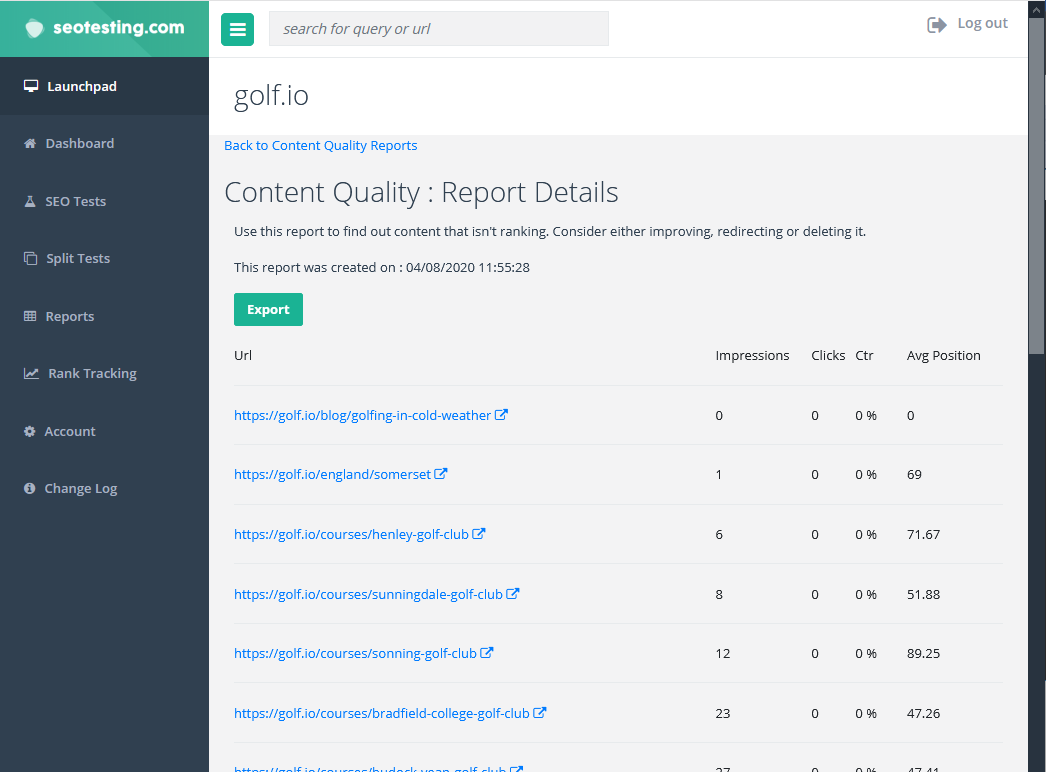Thin content is a blanket term for pages with little to no value to users and holds little SEO value in the eyes of Google.
Google wants to serve the best information to users based on their search query, so you need to do everything you can to make sure your content is educational, reliable, and trustworthy. Not only does thin content hurt user experience, but it can also hurt your SEO in several key ways:
- Reduce Crawl Budget: Google relies on search bots to crawl sites to understand the context and content. This is called “Crawl Budget,” and you should remove thin content to make sure Google crawls the best content on your site.
- Increased Bounce Rate: When content does not satisfy a reader’s needs, they will bounce off your site to find a better solution. This User Metric signals to Google that a page is of low quality, and if you don’t address the Bounce Rate issue quickly, it can drag down the authority of your entire site.
- Keyword Cannibalization: Having multiple pieces of content rank for the same keyword is not always bad, but having thin content that doesn’t provide value could confuse Google and hurt your rankings. Remove thin content to keep the best content on your site that you want Google to index and rank your pages.
As you can see, thin content can hurt your rankings, authority, and user trust. Now that we know what thin content is and how it can hurt your site, let’s look at how to identify thin content and how to fix it to ensure your pages are as strong as they can be.
Where To Find Thin Content On Your Site
Google warns that sites will not rank highly if they do not provide valuable content to users, especially if the webpage violates Google’s Webmaster Guidelines. This means that you should do everything you can to find thin content and either improve or remove the content to improve the overall quality of your site.
It can be challenging to identify thin content, but here are a few sure-fire ways to determine if the content on a page is defined as thin content:
- Lack Of Depth: Content length doesn’t play into Google’s algorithms, but page length is similar to the size of a canvas for an artist to paint on. You want your pages and posts to be long enough so you can share in-depth information with your users. Thin content is usually shallow and lacks sustenance, which takes away from the authority of your site.
- Duplicate Content: Duplicate content, or keyword stuffing, is pretty self-explanatory, and this type of content can hurt your site’s performance. Try to focus on long-tail keywords to reduce duplicate content during the creation process.
- Doorway Pages: A doorway page is a web page created to manipulate search engine indexes for higher rankings. Doorway pages are the hallmarks of Black Hat SEO and should be avoided.
- Shallow Category Pages: Ecommerce sites are notorious for thin category pages and duplicate product pages. Make sure your category pages share lots of value with readers, and you have unique product pages that speak to your customers’ needs.
- Pages With Lots Of Ads: While not all pages with ads are “thin content,” if pages have more ads on them than educational content, then the page is not valuable to your audience.
Now that we have discussed some ways to identify thin content, let’s look at what you should do once you find thin content.
What To Do When You Find Thin Content
The practice of identifying and penalizing thin content is meant to provide a more authentic and reliable user experience for your audience. This means that you need to ensure all of your pages and posts are built with content based on your customers’ needs.
SEOTesting.com makes it easy to identify thin content, but what do you do once you find thin content on your site? Well, there are a few things you can do to fix thin content issues once you find this type of content on your site:
- Improve The Content: The first choice is to improve the content with additional content to build out your message and rich media. You can add rich media like video and images to support the core content of a page. Make sure you choose media that supports your message and enhances the user experience. Siege Media has a great list of 11 ideas to improve your content here.
- Consolidate Content: If a piece of content can’t be improved but has some search traffic, you can 301 redirect it to another piece of content. Be sure to fold that thin content into a relevant piece of content to keep the SEO value and enhance the piece of content you’re folding into.
- Remove Content: If you can’t improve the piece and can’t find a relevant piece of content to 301 redirects and fold into another piece of content.
There is a science to find thin content, and there is an art to determine what to do with the content. You will need to read all content before choosing to improve, consolidate, or remove it from your site based on the search intent of your users.
Be sure to spend time to look at your content from a high level and take a granular look at each piece of content before choosing the direction to take.
Now that we know what to do about thin content let’s look at common types of pages that thin content might appear.
Use SEOTesting’s Content Quality Reporting To Avoid Poor Site Performance
The type of content you offer to your target audience matters. You need high-quality content to build trust with users and help move them along the sales funnel.
The Content Quality report on SEOTesting will quickly locate pages within your website that need to be adjusted. These metrics will show you your organic click-through rate and impressions a specific URL has had over the past three months.
SEOTesting helps you find thin content because the tool will crawl your site’s sitemap.xml to request all clicks and impressions for the past 90 days. With this information, you will be able to see all impressions in ascending order.

Use the Content Quality report in SEOTesting.com to find out which pages get very little impressions and click in the search results.
This means that you can quickly find underperforming content based on the strength of your site and your own grading system. SEOTesting helps reduce time spent sifting through sitemap files and allows you to focus on value-added services and deliverables for your clients!

Thin Content FAQs
What are striking distance keywords?
Striking distance keywords are the specific keywords your site ranks for within the 11th to 30th position, which have the best potential of gaining more clicks.
Why should I run SEO Testing?
SEO testing is essential because its algorithm shows you what works for your website and what needs improvements.
Does social media affect SEO?
While social media does not directly contribute to your SEO ranking, the links you share on social platforms will improve brand exposure.

